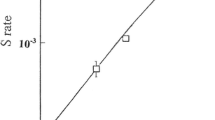Abstract
The process of segregation or phenotypic expression of two recessive drug-resistant loci from heterozygous Chinese hamster ovary hybrid lines is examined. The spontaneous segregation rates of phytohaemagglutinin resistance (Phar) and a temperature-dependent 8-azaguanine-resistant locus (Azarts) from heterozygous quasitetraploid lines using Luria-Delbruck fluctuation analysis were 5×10−5 and 10−5 events/cell/generation, respectively. In quasihexaploid lines, the latter rates increased 40-and 200-fold, respectively, and were dependent on the number of presumptive drug-sensitive alleles. The mutagens EMS, MNNG, ICR-170, ICR-191, and γ rays significantly increased the frequency of segregation events. The mutagen-induced frequency of dominant mutations to ouabain (OuaR) and α-amanitin (AmaR) resistance in the same hybrid line was much lower in comparison to segregation events and was mutagen specific. The chromosome number per metaphase cell was more variable than DNA content in quasitetraploid lines. These properties of marker segregation are consistent with mechanisms of either restricted chromosome loss, rearrangement, or mutation.
Similar content being viewed by others
Literature cited
De Mars, R. (1974).Mutat. Res. 24:335–364.
Siminovitch, L. (1976).Cell 7:1–11.
Thompson, L.H., and Baker, R.M. (1973). InMethods in Cell Biology, Vol. 6, Prescott, D.M. (ed), Academic Press, New York, pp. 209–281.
Chasin, L.A. (1973).J. Cell. Physiol. 82:299–308.
Chasin, L.A., and Urlaub, G. (1975).Science 187:1091–1093.
Chasin, L.A. (1972).Nature New Biol. 240:50–52.
Marin, G. (1969).Exp. Cell Res. 57:29–36.
Harris, M. (1975).J. Cell. Physiol. 86:413–430.
Harris, J.F., and Whitmore, G.F. (1974).J. Cell. Physiol. 83:43–51.
Stanley, P., Caillibot, V., and Siminovitch, L. (1975).Somatic Cell Genet. 1:3–26.
Stanley, P., Caillibot, V., and Siminovitch, L. (1975).Cell 6:121–128.
Stanley, P., Siminovitch, L., Nariasimhian, S., and Schachter, H. (1975).Proc. Natl. Acad. Sci. USA 72:3323–3327.
Baker, R.M., Brunette, D.M., Mankovitz, R., Thompson, L.H., Whitmore, G.F., Siminovitch, L., and Till, J.E. (1974).Cell 1:9–21.
Lobban, P.E., and Siminovitch, L. (1975).Cell 4:167–172.
Ingles, C.J., Guialis, A., Lam, J., and Siminovitch, L. (1976).J. of Biol. Chem. 251:2729–2734.
Chan, V.L., Whitmore, G.F., and Siminovitch, L. (1972).Proc. Natl. Acad. Sci. USA 69:3119–3123.
Stanners, C.P., Eliceiri, G., and Green, H. (1971).Nature New Biol. 230:52–53.
Borsa, J., and Whitmore, G.F. (1969).Mol. Pharmacol. 5:303–317.
McBurney, M.W., and Whitmore, G.F. (1974).Cell 2:173–182.
Thompson, L.H., Harkins, J.L., and Stanners, C.P. (1973).Proc. Natl. Acad. Sci. USA 70:3094–3098.
Deaven, L.L., and Peterson, D.F. (1974). InMethods in Cell Biology, Vol. 8, Prescott, D.M. (ed), Academic Press, New York, pp. 179–204.
Van Dilla, M., Steinmetz, L., Davis, D., Calvert, R., and Gray, J. (1974).I.E.E.E. Trans. Nucl. Sci. NS-21:714–720.
Luria, S.E., and Delbruck, M. (1943).Genetics 28:491–511.
Lea, D.E., and Coulson, C.A. (1949).J. of Genet. 49:264–285.
Burch, P.R.J. (1965).Proc. R. Soc. London 162B:223–239.
Alper, T., Fowler, J.F., Morgan, R.L., Vonberg, D.D., Ellis, F., Oliver, R. (1962).Br. J. Radiol. 35:722–723.
Hsie, A.W., Brimer, P.A., Mitchell, T.J., Gosslee, D.G. (1975).Somatic Cell Genet. 1:247–261.
Arlett, C.F., Turnbull, D., Harcourt, S.A., Lehmann, A.R., and Colella, C.M. (1975).Mutation Res. 33:261–278.
Baker, W.K. (1968).Advan. Genet. 14:133–169.
Kraemer, P.M., Peterson, D.F., and Van Dilla, M.A. (1971).Science 174:714–717.
Gray, J.W., Carrano, A.V., Steinmetz, L.L., Van Dilla, M.A., Moore, D.H., Mayall, B.H., and Mendelsohn, M.L. (1975).Proc. Natl. Acad. Sci. USA 72:1231–1234.
Worton, R.G., Ho, C.C., and Duff, C. (1977).Somatic Cell Genet. 3:27–46.
Author information
Authors and Affiliations
Rights and permissions
About this article
Cite this article
Harris, J.F., Whitmore, G.F. Segregation studies in CHO hybrid cells: I. Spontaneous and mutagen-induced segregation events of two recessive drug-resistant loci. Somat Cell Mol Genet 3, 173–193 (1977). https://doi.org/10.1007/BF01551813
Received:
Revised:
Issue Date:
DOI: https://doi.org/10.1007/BF01551813




